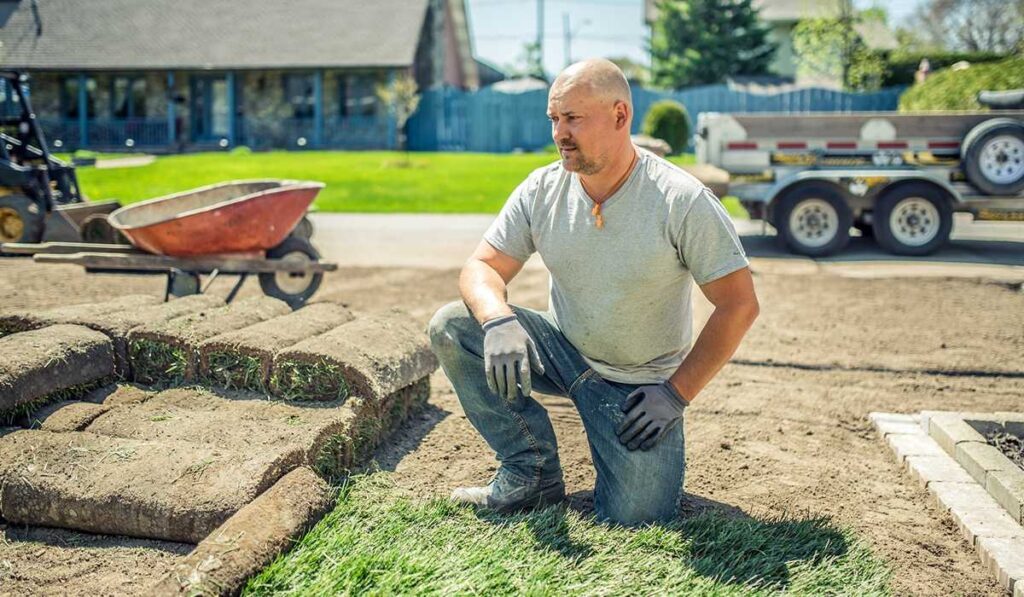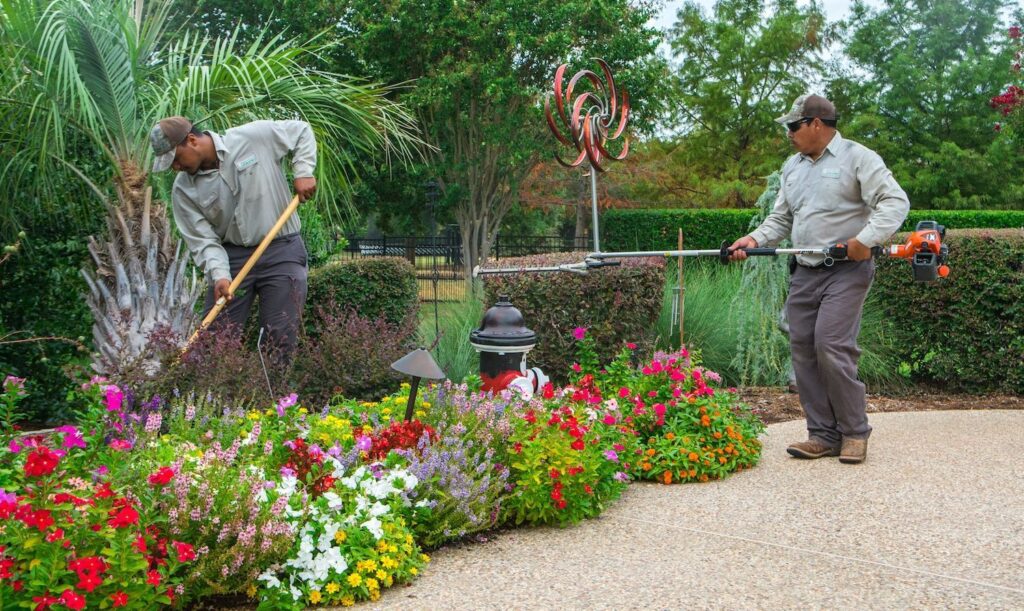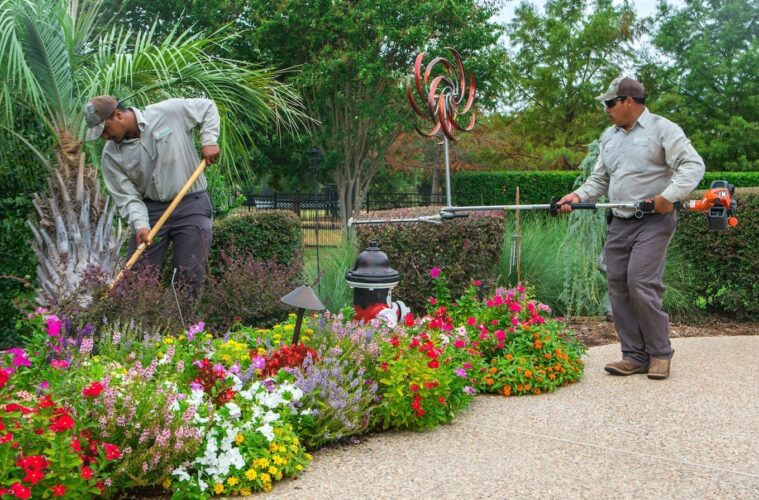The scent of freshly cut grass in the early morning is a delightful experience. While some savor the well-maintained landscapes, others perceive something more – money. Indeed, beginning or investing in a landscaping business can be a lucrative venture, and the initial costs may be more manageable than you’d expect. In this article, we will get into the essential aspects and expenses of launching a landscaping business, offering you a comprehensive insight into the financial requirements for starting your landscaping venture.
What makes a landscaping a low cost start-up business ?

source: pinterest.com
A landscaping business offers the advantage of being a low-cost startup for several reasons. The core factors include minimal overhead, as it often doesn’t require a dedicated physical storefront or extensive equipment, and it relies on the skills and expertise of the owner, a small team and most importantly buying the best tools for landscapers need. Moreover, the nature of the work allows for gradual expansion, meaning you can start with essential tools and add more as your business grows. Additionally, the demand for landscaping services tends to remain steady, making it a viable option for entrepreneurs with limited capital looking to enter the world of business ownership.
Landscaping Start-up cost
Starting your own landscaping business is an exciting endeavor, but it’s important to understand how much it will cost to start a landscaping business and by all means these are rough estimates as prices and models varies but it will give you a great idea so In this guide, we’ll break down the essential expenses and considerations to help you become a successful landscaping entrepreneur.
Step 1: Research and Planning

source: pinterest.com
Begin by researching the landscaping industry in your area. Look at your potential competition and your target market. Consider the services you’ll offer, such as lawn care, garden design, or tree trimming. A well-researched business plan is essential to outline your goals and strategies.
Step 2: Legal Requirements
To operate legally, you’ll need to register your business. This typically costs around $100 to $400. You may also need licenses or permits, which can vary in cost depending on your location and keep in mind some states require additional license to operate – Contact your local state office!
Step 3: Equipment and Tools
The cost of landscaping equipment varies, but a basic set can start at around $5,000 to $10,000. This includes items like mowers, trimmers, leaf blowers, and hand tools. As your business grows, you can invest in more specialized equipment, but you dont need to spend all at once you can buy as you grow your landscaping business.
Step 4: Vehicle

source: pinterest.com
A dependable work vehicle is a must. A used pickup truck or van can cost between $10,000 and $20,000. You may also need to budget for insurance and vehicle maintenance, now you can work out your car too depending how you start its better to grow customer at a time to scale your business so this can be slashed to $1500!
Step 5: Marketing and Branding
Setting up a website, creating business cards, and advertising in local directories can cost approximately $500 to $1000. Marketing is essential to attract customers.
Step 6: Insurance
Liability insurance is vital to protect your business from potential claims. It can range from $500 to $1,000 annually, depending on your coverage.
Step 7: Initial Material Costs
You’ll need to purchase initial materials like mulch, soil, and plants. This can vary greatly based on the size and scope of your projects, but budget around $500 to $1,000 initially.
Step 8: Labor
If you’re not doing all the work yourself, you’ll need to budget for labor costs. The initial weekly salary for each help can be approximately $500to $1000 per employee depending on their skill set.
Step 9: Additional Expenses

source: pinterest.com
Don’t forget to budget for unexpected expenses and a financial cushion for the first few months of operation.
In summary, the total initial cost to start a landscaping business can vary widely depending on the scale of your venture, but it typically ranges from $5,000 to $50,000 based on your prefecnces and how you want to start, are you a go big or go home person or are you a slowly but surely person so This estimate covers the basics you’ll need to get your business up and running. Keep in mind that as your business grows, you may need to invest in more equipment and personnel.
Starting a landscaping business is not just a great entrepreneurial endeavor; it’s also a platform for showcasing one’s creativity and the knack for turning the ordinary into the extraordinary. As we’ve delved into the details, it becomes evident that success in this field hinges on a combination of skills, strategic choices, and investing in the right tools. Here’s why venturing into the world of landscaping is an appealing and promising path.
Skills Matter Most: Landscaping isn’t merely about mowing lawns or planting flowers; it’s about understanding the nuances of nature. Knowing how to transform outdoor spaces into something beautiful and functional takes a keen eye and a deep appreciation for the environment. Landscaping professionals need to comprehend the terrain, climate, and various plant species. This means having the skills to visualize how elements will fit together in a cohesive and aesthetically pleasing way. Such skills can’t be bought; they’re developed over time and through experience.
Art and Science Combined: Landscaping is the perfect blend of art and science. It’s about knowing the right plants and materials to use for different projects, understanding soil conditions, and selecting the right location for each element. A successful landscaping business is rooted in the ability to create landscapes that harmonize with their surroundings while meeting the practical needs of clients. This interplay between creativity and science is what sets landscaping apart.
Tools of the Trade: Investing in the best tools for landscapers and equipment is crucial. A well-maintained lawnmower, sharp pruning shears, quality mulch, and the right kind of soil can make all the difference in your work. In addition to enhancing efficiency, these tools also speak to the quality of your service. Clients appreciate when you arrive with the best tools, and it makes your job easier. While the initial investment in these tools may seem significant, it’s an investment that pays off over time through improved results and client satisfaction.
Transforming Spaces: Landscaping isn’t just about aesthetics; it’s about transforming spaces. A well-landscaped property can increase its value, improve curb appeal, and create functional outdoor living areas. It’s about making a positive impact on people’s lives by providing them with beautiful surroundings where they can relax and enjoy nature. This transformation aspect is what makes landscaping an emotionally rewarding profession.
In conclusion, a landscaping business is a journey that blends artistic flair, scientific knowledge, and the right tools to create beautiful outdoor spaces. It’s a path that allows you to leverage your skills to enhance not only the aesthetics but also the functionality of the environment. By investing in your skills and using the best tools, you can create a business that not only thrives but also brings joy to the lives of your clients. It’s not just about working with the land; it’s about making it come alive with your vision and expertise.



